
Estratti del catalogo

Notice d’utilisation SUP’AIR - VLD 34 rue Adrastée Parc Altaïs 74650 Annecy - Chavanod FRANCE 45°54.024’N / 06°04.725
Aprire il catalogo a pagina 1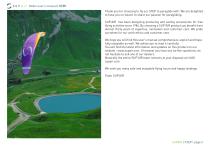
Glider user's manual | STEP Thank you for choosing to fly our STEP to paraglide with. We are delighted to have you on-board to share our passion for paragliding. SUP'AIR has been designing producing and selling accessories for free flying activities since 1984. By choosing a SUP'AIR product you benefit from almost thirty years of expertise, innovation and customer care. We pride ourselves for our work ethics and customer care. We hope you will find this user's manual comprehensive, explicit and hopefully enjoyable as well. We advise you to read it carefully. You will find the latest...
Aprire il catalogo a pagina 2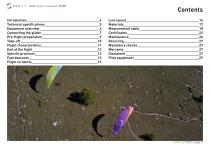
Glider user's manual | STEP Introduction Technical specifications Equipment overview Connecting the glider Pre-flight preparation Take-off Flight characteristics End of the flight Specific practices Fast descents Flight incidents Line layout Materials Measurement table Certificates Maintenance Recycling Mandatory checks Warranty Disclaimer Pilot equipment SUPAIR | STEP | page 3
Aprire il catalogo a pagina 3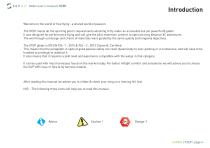
Glider user's manual | STEP Welcome to the world of free flying : a shared world of passion. The STEP meets all the sporting pilot's requirements whishing to fly under an accessible but yet powerful B glider. It was designed for performance flying and will give the pilot maximum comfort to optimize long distance XC adventures. The well though out design and choice of materials were guided by the same quality and longevity objectives. The STEP glider is EN EN 926 -1 : 2015 & 926 - 2 : 2013 Classe B. Certified. This means that the paraglider in spite of good passive safety can react...
Aprire il catalogo a pagina 4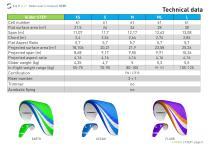
Glider user's manual | STEP Glider STEP Cell number Flat surface area (m²) Span (m) Chord (m) Flat Aspect Ratio Projected surface area (m²) Projected span (m) Projected aspect ratio Glider weight (kg) In-flight weight range (kg) Certification Riser number. Trimmer Acrobatic flying FLUOR SUPAIR | STEP | page 5
Aprire il catalogo a pagina 5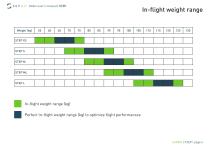
Glider user's manual | STEP In-flight weight range 70 STEP XS STEP S STEP M STEP ML STEP L In-flight weight range (kg) Perfect In-flight weight range (kg) to optimize flight performances SUPAIR | STEP | page 6
Aprire il catalogo a pagina 6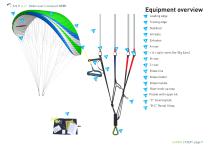
Glider user's manual | STEP Equipment overview Brake holder Brake handle Riser hook-up loop Brake line « A » split risers (for Big Ears) Trailing edge Leading edge Pocket with repair kit. "C" steering ball. "B-C" Recall Strap. SUPAIR | STEP | page
Aprire il catalogo a pagina 7
Glider user's manual | STEP Choose a flat or lightly angled training hill without obstacles or wind. Open your wing and arrange it in a crescent shape. Check the fabric and the lines for any sign of wear or damage. Check for the links connecting the lines to the risers to be fully closed. Identify, separate and arrange the A,B.C, risers as well as the brake lines neatly. Knots or tangles can not be present. Choosing an adapted harness. The STEP glider was certified EN B with a EN1651 & LTF certified harness and hence can be flown with most harnesses models found on the market today. Meaning...
Aprire il catalogo a pagina 8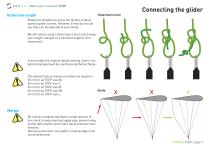
Glider user's manual | STEP Brake line length fisherman's knot Brake line lengths are set at the factory to allow optimal glider control. However, if they do not suit you they can be adjusted to your liking. We will advise using a fisherman's knot and to keep your length changes to a minimum (approx 5cm maximum). If you modify the original default setting, have it inspected and approved by a professional before flying.. The default factory maximum brake line length is : 55 cm for an STEP size XS 60 cm for an STEP size S 62 cm for an STEP size M 65 cm for an STEP size ML 67 cm for an STEP...
Aprire il catalogo a pagina 9
Glider user's manual | STEP PRE-FLIGHT PREPARATION The STEP wing was designed for for recreational pilots, sportsmen, who want a high performance sailing, at the top of category B. To discover your new wing, we will advise you to conduct your first small flights in calm conditions on a school training hill or a familiar site you are used to flying with your own harness. Unfold the glider and place it on its upper surface in an arc. Separate the A,B,C risers and the brakes, be certain for the risers and lines not to have any twists or knots or be hooked to a branch, stone etc... Caution ! It...
Aprire il catalogo a pagina 10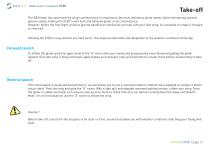
Glider user's manual | STEP The R&D team has optimized the wing's performance in response to the most ambitious pilots needs, while maintaining optimal passive safety, making the STEP a well built and behaved glider in all circumstance. However, before the first flight, practice ground handling to familiarize yourself with your new wing. It is possible to inflate it forward or reversed. Inflating the STEP is easy without any hard point ; the sequence demands and adaptation to the weather conditions of the day. Forward launch To inflate the glider grab the upper ends of the "A" risers with...
Aprire il catalogo a pagina 11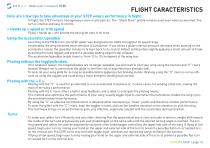
Glider user's manual | STEP FLIGHT CARACTERISTICS Here are a few tips to take advantage of your STEP wing's performance in flight: In flight, the STEP remains homogeneous even in turbulent air. The "Shark Nose" profile remains solid even when accelerated. The turn is intuitive and easy to control. « Hands up » speed or trim speed Flying « hands up » will provide the best glide ratio in nil wind. According to the EN B norm, the STEP glider was designed to be stable throughout its speed range. Accelerated, the wing becomes more sensitive to turbulence. If you sense a glider internal pressure...
Aprire il catalogo a pagina 12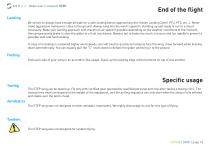
Glider user's manual | STEP Landing Be certain to always have enough altitude for a safe landing before approaching the chosen Landing Zone ( PTU, PTS, etc...). Never make aggressive maneuvers close to the ground. Always land into the wind ( upwind ), standing up and ready to run to a stop if necessary. Make your landing approach with maximum air speed if possible depending on the weather conditions of the moment, then progressively brake to slow the glider to a final touchdown. Beware not to brake too much, too soon and too rapidly to prevent a possible stall and hard landing. In case of a...
Aprire il catalogo a pagina 13Tutti i cataloghi e le schede tecniche SupAir-VLD
-
RADICAL 3
30 Pagine
-
VIP LITE
14 Pagine
-
EVEREST3
18 Pagine
-
MINIMAX BUMP
17 Pagine
-
EVO LITE
39 Pagine
-
DELIGHT 3
31 Pagine
-
SKYPPER 2
37 Pagine
-
ACRO 4
34 Pagine
-
ALTIRANDO LITE
33 Pagine
-
PIXAIR 2
35 Pagine
-
ACCESS 2 BUMP
38 Pagine
-
ACCESS 2 AIRBAG
37 Pagine
-
MINIMAX 3
22 Pagine
-
WALIBI 3
38 Pagine
-
STRIKE 2
40 Pagine
-
KINDER 2
20 Pagine
-
LOUSTIC 2
20 Pagine
-
FLUID
30 Pagine
-
START
15 Pagine
-
SHINE
22 Pagine
-
LEAF 2
36 Pagine
-
LEAF 2 LIGHT
32 Pagine
-
SAVAGE
30 Pagine
-
STEP light
29 Pagine
-
SORA 2 PLUS
28 Pagine
-
EONA 3
36 Pagine
-
CATALOGUE SUPAIR 2017 2018
39 Pagine



































